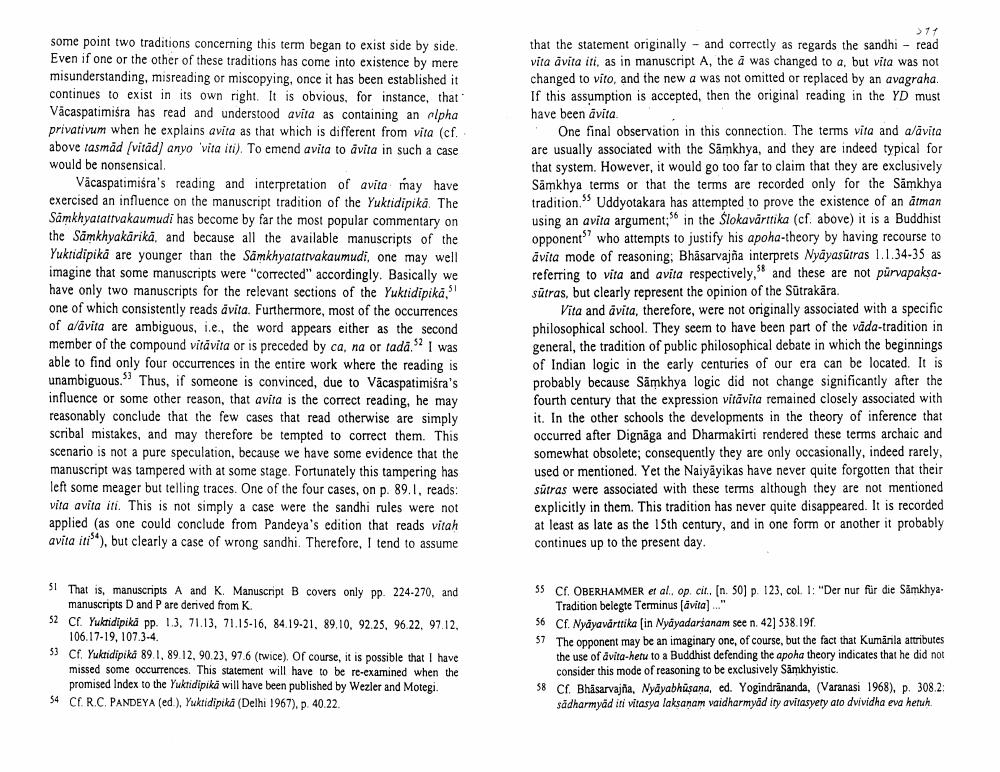Book Title: Avita And Avita Author(s): Eli Franco Publisher: Eli Franco View full book textPage 8
________________ some point two traditions concerning this term began to exist side by side. Even if one or the other of these traditions has come into existence by mere misunderstanding, misreading or miscopying, once it has been established it continues to exist in its own right. It is obvious, for instance, that Vacaspatimisra has read and understood avita as containing an alpha privativum when he explains avita as that which is different from vita (cf. above tasmad (vitad) anyo 'vita iti). To emend avita to avita in such a case would be nonsensical. Vacaspatimisra's reading and interpretation of avita may have exercised an influence on the manuscript tradition of the Yuklidipika. The Samkhyatattvakaumudi has become by far the most popular commentary on the Samkhyakarika, and because all the available manuscripts of the Yuktidipika are younger than the Samkhyatattvakaumudi, one may well imagine that some manuscripts were "corrected" accordingly. Basically we have only two manuscripts for the relevant sections of the Yuktidipika," one of which consistently reads avita. Furthermore, most of the occurrences of alavita are ambiguous, i.e., the word appears either as the second member of the compound vitavita or is preceded by ca, na or tada."? I was able to find only four occurrences in the entire work where the reading is unambiguous. Thus, if someone is convinced, due to Vacaspatimisra's influence or some other reason, that avita is the correct reading, he may reasonably conclude that the few cases that read otherwise are simply scribal mistakes, and may therefore be tempted to correct them. This scenario is not a pure speculation, because we have some evidence that the manuscript was tampered with at some stage. Fortunately this tampering has left some meager but telling traces. One of the four cases, on p. 89.1, reads: vita avita iti. This is not simply a case were the sandhi rules were not applied (as one could conclude from Pandeya's edition that reads vitah avita iti$4), but clearly a case of wrong sandhi. Therefore, I tend to assume 371 that the statement originally - and correctly as regards the sandhi - read vita avita iti, as in manuscript A, the a was changed to a, but vita was not changed to vito, and the new a was not omitted or replaced by an avagraha. If this assumption is accepted, then the original reading in the YD must have been avita. . One final observation in this connection. The terms vita and alavita are usually associated with the Samkhya, and they are indeed typical for that system. However, it would go too far to claim that they are exclusively Samkhya terms or that the terms are recorded only for the Samkhya tradition." Uddyotakara has attempted to prove the existence of an atman using an avita argument;56 in the Slokavarttika (cf. above) it is a Buddhist opponent" who attempts to justify his apoha-theory by having recourse to avita mode of reasoning; Bhasarvajna interprets Nyayasutras 1.1.34-35 as referring to vita and avita respectively, 58 and these are not purvapaksasutras, but clearly represent the opinion of the Sutrakara. Vita and avita, therefore, were not originally associated with a specific philosophical school. They seem to have been part of the vada-tradition in general, the tradition of public philosophical debate in which the beginnings of Indian logic in the early centuries of our era can be located. It is probably because Samkhya logic did not change significantly after the fourth century that the expression vitavita remained closely associated with it. In the other schools the developments in the theory of inference that occurred after Dignaga and Dharmakirti rendered these terms archaic and somewhat obsolete; consequently they are only occasionally, indeed rarely, used or mentioned. Yet the Naiyayikas have never quite forgotten that their sutras were associated with these terms although they are not mentioned explicitly in them. This tradition has never quite disappeared. It is recorded at least as late as the 15th century, and in one form or another it probably continues up to the present day. 51 That is, manuscripts A and K. Manuscript B covers only pp. 224-270, and manuscripts D and P are derived from K. 52 Cf. Yuktidipika pp. 1.3, 71.13, 71.15-16, 84.19-21, 89.10, 92.25, 96.22, 97.12, 106.17-19, 107.3-4. 53 Cf. Yuktidipika 89.1, 89.12, 90.23, 97.6 (twice). Of course, it is possible that I have missed some occurrences. This statement will have to be re-examined when the promised Index to the Yuktidipika will have been published by Wezler and Motegi. 54 Cf. R.C. PANDEYA (ed.), Yuktidipika (Delhi 1967), p. 40.22. 55 Cf. OBERHAMMER et al., op. cit., (n. 50] p. 123, col. 1: "Der nur fur die Samkhya Tradition belegte Terminus (avita)..." 56 Cf. Nyayavarttika (in Nyayadarsanam see n. 42] 538.19f. 57 The opponent may be an imaginary one, of course, but the fact that Kumarila attributes the use of avita-hetu to a Buddhist defending the apoha theory indicates that he did not consider this mode of reasoning to be exclusively Samkhyistic. 58 Cf. Bhasarvajna, Nyayabhusana, ed. Yogindrananda, (Varanasi 1968), p. 308.2: sadharmyad iti vitasya laksanam vaidharmyad ity avitasyety ato dvividha eva hetuh.Page Navigation
1 ... 6 7 8
